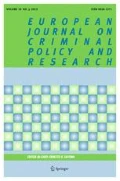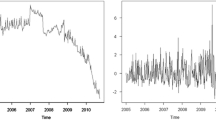Abstract
For the first time, the UK Criminal Justice Act (1991) allowed the videotaped evidence of a child to be substituted for the child's evidence-in-chief in a criminal court. The present study is an evaluation of that legislation. One hundred and fifty children were observed testifying in a criminal court in the UK. The use of the videotaped evidence and subsequent cross-examination of the child witness (usually via the closed circuit television system) was also observed. The data base from the Lord Chancellor's Department of all trials involving child witnesses in England and Wales was also analysed. The results showed that the introduction of the video technology into the criminal courts reduced the levels of stress of child witnesses but did not increase the conviction rates.
Similar content being viewed by others
References
Ceci, S. and M. Bruck, Jeopardy in the Courtroom. Washington, DC: American Psychological Association, 1995.
Cashmore, J. and N. DeHass, The Use of Closed Circuit Television for Child Witnesses in the ACT. A Report for the Australian Law Reform Commission and the Australian Capital Territory Magistrates Court, 1992.
Crown Prosecution Service Inspectorate, The Inspectorate's Report on Cases Involving Child Witnesses. London: CPS Inspectorate 1998.
Davies, G.M., The impact of television on the presentation and reception of children's evidence. International Journal of Law and Psychiatry, forthcoming.
Davies, G.M. and E. Noon, An Evaluation of the Live Link for Child Witnesses. London: Home Office, 1991.
Davies, G. and H. Westcott, Videotechnology and the child witness. In: H. Dent and R. Flin (Eds), Children as Witnesses. Chichester: John Wiley and Sons, 1992.
Davies, G.M., J.C. Wilson, R. Mitchell and J. Milsom, Videotaping Children's Evidence: An Evaluation. London: HMSO, 1995.
Flin, R.H., G. Davies and A. Tarrant, The Child Witness. Final Report to the Scottish Home and Health Department. Grant 85/9290. Aberdeen: Robert Gordon's Institute of Technology, 1988.
Goodman, G.S., The child witness: Conclusions and future directions for research and legal practice. Journal of Social Issues, 40, pp. 157–175 1984.
Goodman, G., E. Taub, D. Jones, P. England, L. Port, L. Rudy and L. Prado, Testifying in criminal court. Monograph of the Society for Research in Child Development, 57(5), 1992.
Goodman, G., M. Wilson, C. Hazen and R. Reed, Children's testimony nearly four years after the event. Paper presented at the annual meeting of the Eastern Psychological Association, Boston, MA, 1989.
Home Office, Report of the Advisory Group on Video Evidence. London: Home Office, 1989.
Home Office and Department of Health. The Memorandum of Good Practice on Video Recorded Interviews with Child Witnesses for Criminal Proceedings. London: HMSO, 1992.
Lipovsky, J., The impact on court on children: Research findings and practical recommendations. Journal of Interpersonal Violence, 9, pp. 238–257, 1994.
Lipovsky, J., R. Tidwell, J. Crisp, D. Kilpatrick, B. Saunders and V. Dawson, Child witnesses in criminal court: Descriptive information from three southern states. Law and Human Behavior, 16, pp. 635–650, 1992.
McFarlane, K., Diagnositic evaluations and the use of videotapes in child sexual abuse cases. University of Miami Law Review, 40, pp. 135–165, 1985.
Melton, G, G. Goodman, S. Kalichman, M. Levine, K. Saywitz and G. Koocher, Empirical research on child maltreatment and the law. Journal of Child Psychology, 24(Suppl.), pp. 47–77, 1995.
Parker, J. The rights of child witnesses: Is the court a protector or perpetrator? New England Law Review, 17, pp. 643–717, 1982.
Pipe, M.E. and J.C. Wilson, Cues and secrets: Influences on children's event reports. Developmental Psychology, 30, pp. 515–525, 1994.
Saywitz, K. and G. Goodman, Interviewing children in and out of court: Current research and practice implications. In: J. Briere, L. Berliner, J. Bulkey, C. Jenny and T. Reid (Eds), The APSAC Handbook of Child Maltreatment, pp. 297–318. London: Sage, 1996.
Saywitz, K.J. and L. Snyder, Improving children's testimony with preparation. In: G.S. Goodman and B.L. Bottoms (Eds), Child Victims, Child Witnesses: Understanding and Improving Testimony, pp. 117–146. New York: Guilford, 1993.
Swim, J.K., E. Borgida and K. McCoy, Videotaped versus in-court witness testimony: Does protecting the child witness jeopardise due process? Journal of Applied Social Psychology, 23, pp. 603–631, 1993.
Rights and permissions
About this article
Cite this article
Wilson, J., Davies, G. An Evaluation of the Use of Videotaped Evidence for Juvenile Witnesses in Criminal Courts in England and Wales. European Journal on Criminal Policy and Research 7, 81–96 (1999). https://doi.org/10.1023/A:1008740231642
Issue Date:
DOI: https://doi.org/10.1023/A:1008740231642




